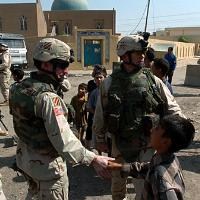As the United States, Russia and Bashar al-Assad’s regime in Syria engage in a complicated diplomatic dance, Washington remains fixated on Syrian chemical weapons, leaving what may be a more important issue—America's relationship with the Syrian rebels—muddled. The U.S. supports one rebel faction but not enough to allow it to win outright, fearing that doing so will inadvertently help extremists affiliated with al-Qaida or taint the United States with the misdeeds of its rebel allies. This is simply the latest example of the confusion and uncertainly that has long characterized America's dealings with militias.
Although the U.S. military itself grew out of local militias, over time the United States came to prefer partners that looked like its own security forces: hierarchical, disciplined organizations led by trained professionals who concentrated on national security and, for the most part, left policymaking to civilians. When the U.S. assists the militaries of other nations, it tries to mold them this way as much as possible. The more the partners resemble U.S. forces, the closer the ties. This reflects a long tradition. Americans were never big on arming and manipulating Native American militias, recognizing that one-time allies could later become deadly enemies. But in other parts of the world the United States saw utility in helping irregular security forces. For the U.S. Army Special Forces, there was a name for this—unconventional warfare—and official doctrine (.pdf). But this was always at the far edges of American strategy, only to be used when there were no other viable options.
During the Vietnam conflict, the local militias—the Regional Forces and Popular Forces—had some success against Viet Cong guerrillas. And in Nicaragua during the 1980s, the U.S.-backed Contras increased pressure for the elections that removed the Soviet-backed Sandinistas from power. But most of the time, U.S. alliances with irregular forces did not end well. In Vietnam's Mekong Delta and Central Highlands, in Afghanistan during the fight to drive out Soviet forces and during the Anbar Awakening in Iraq, the pattern was for U.S. support to dry up once the immediate goals were attained or abandoned. The relationship with the irregular forces was always a temporary and undesirable expedient. Unlike most of history's other great powers who managed security in restive parts of the world, the United States never fully integrated partnerships with nonstate fighters into its strategy.

